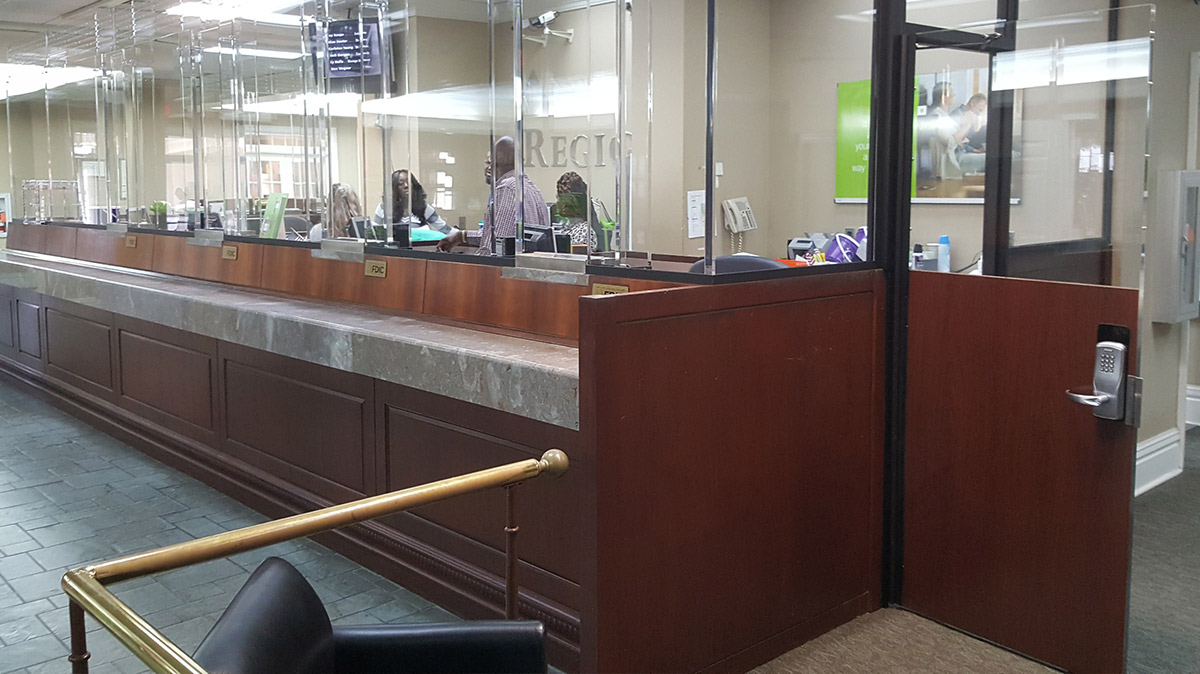How do you know if someone is really able to build high-quality and robust bank security systems? In most fields, if you want to quickly assess the level of craftsmanship there are a few key details that offer big insights. For example, most realtors know to look at the quality of the finish work in a house’s closets. A builder who made sure their crew finished the closet interiors—drywall seams smoothly taped and mudded, fully painted, tidy trim work—has almost certainly made sure all the important work has been done right.
Bullet-resistant bank security systems are no different. As a general rule, people who are cutting corners that you can see are cutting even more corners where you can’t. This might include:
- Cheating on fiberglass coverage within the walls or behind counters.
- Skipping filling behind drawers or inside framing (rather than custom cutting them).
- Using non-rated window frames without even offering the option of rated bullet-resistant framing.
“We’ve been doing bulletproof systems in banks for a long time,” explains Jim Richards, CEO of Total Security Solutions. “That whole industry really started here in Southeast Michigan, with Detroit. We know from experience how important it is for that bank security system to look the best it can, and perform the best it can. More importantly, we know that the two go hand in hand.”
As you click through a potential bulletproofing partner’s website and look at their portfolio, there are four key details that offer big insights into the overall quality of their work: Corners, Doors, Complexity, and Aesthetics.
Cutting Corners with Bank Security Systems
Pay special attention to the exposed edges, corners, and the bulletproof acrylic transparency. These should be bright and clear. Keep an eye out for complex edge cuts like this one:
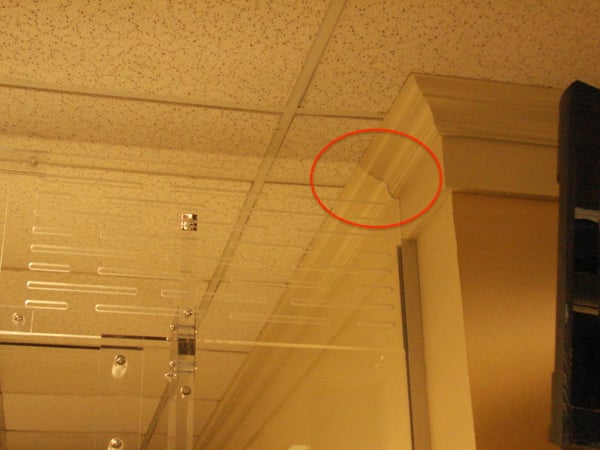
look for bank security systems and windows with custom edge cuts and profiles
They won’t come up in every job, but if your installer never seems to do anything more complicated, that’s a red flag. A complex edge like this was done on a CNC machine and should be well within the capabilities of most fabricators.
“I’m not going to say we always do it,” says Jim. “It really depends on the branch, the budget, what the customer wants or needs. Sometimes it makes more sense to take down the molding, cut it, and butt it up against the glass. Sometimes we’ll miter the corner. It all depends.”
What bears noting is if you never see a piece of acrylic cut to match a complex profile. If they can’t do that sort of work, it’s a bad sign. If they can’t be bothered to do it, that’s even worse.
For more information on bulletproof barriers for banks, download our “How-To Guide for Banks.”
Bank Doors: Small Challenges with Big Impacts
Doors are another area where a bulletproof manufacturer’s fundamentals are on display. Are they always using standard solid wood or steel doors? If every bank install they showcase uses basically the same doors, they are almost certainly buying them from a third party. There’s nothing wrong with that—there are lots of high-quality bulletproof doors on the market.
“But it’s rare that you can get a standard door to fit perfectly into every bank retrofit,” Jim says. “You’ve gotta fit what’s there, which means custom-making your own doors more often than not.”
If a company is always using a standard door, then they may also be moving around counters or cutting holes in walls to accommodate those doors.
Take special note of how your prospective partner handles the gates in a half wall. The right way to handle this situation is what you see here:
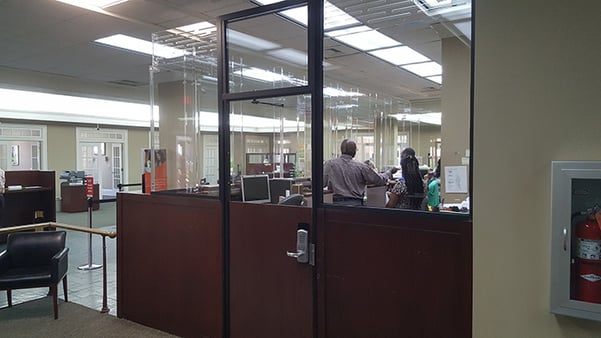
bank security systems usually demand custom doors
The bulletproof manufacturer should fabricate an all-acrylic door and then laminate a matching wood veneer to the bottom half. This doesn’t just create a nice, smooth look. It also makes for better security overall, because you have a continuous piece of bullet-resistant material with no seam or gap.
“A lot of people just put a solid wood or steel door in to replace a gate,” Jim says, “because they aren’t adept at making acrylic doors—or aren’t making their own doors at all. It isn’t a bad solution, exactly. But depending on where the gate is located, having that full door in that half wall can be visually very distracting.”
A bulletproof barrier manufacturing company working in banks today should be able to fabricate a door to almost any specification.
Many Installs, Few Pieces, Few Components
Be wary of a company whose entire portfolio is big slabs of monolithic acrylic held up by chunky framing. In most cases, the simple solution is the best one. But even a company that is good at finding simple solutions should still be able to design and fabricate complex systems. Bringing together multiple elements and components is challenging. You have to respect precision, accuracy, proper tolerancing, and have the means to fabricate to those specifications. Tiny errors can stack up quickly and then result in the system not coming together smoothly (or at all) during installation. You want to work with a company like Total Security Solutions, that can bring together many pieces when the situation demands it, and absorb the inevitable hiccups and headaches.
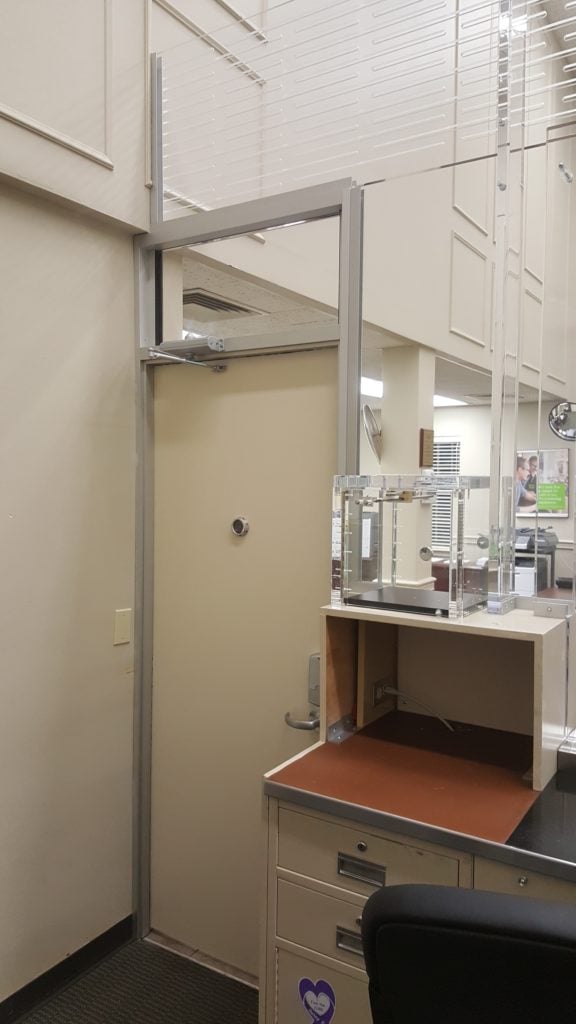
bank security systems often require a larger number of pieces and components
“That’s why we hire carpenters—not just anyone—for our installation teams. Our installers are skilled tradespeople and are problem-solvers so if something does go wrong, they have the skills and experience to make it right. That’s where you see the fit and finish. If they ding a wall during an install, they’re going to get the mud out, they’re going to patch it, they’re going to paint it. Ninety-Nine percent of the time, the customer would never know it had happened. Our staff and installation crew is always going to make the situation right.”
Aesthetics: Making Mindful Choices
Aesthetics are subtle but powerful. A bank security manager often doesn’t notice a poor aesthetic choice until after the fact, when they see how the look of their building interior is impacting how visitors feel and interact.
For example, notice how the tops of the arch windows in this bank teller line all align, even as the counter dips to accommodate low-stature customers and wheelchair users:
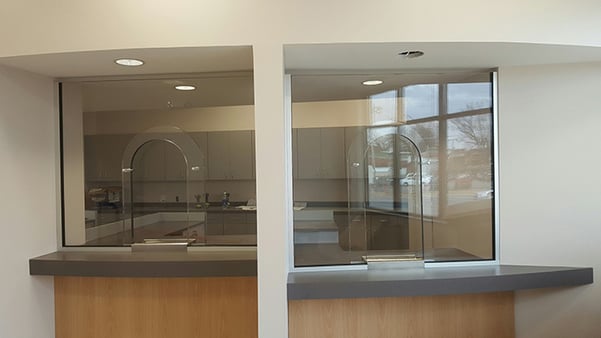
a properly aesthetically balanced teller line
According to Jim, “This is the right thing to do, so it’s how we do it. Yes, it’s cheaper to always use the exact same arch backer and have it drop down with the counter. But we want them to all finish at 72-inches above the floor. Otherwise the visual isn’t right. When the top of that arch drops down at each ADA-compliant station, you might be sending this message you don’t mean to send, that the person who uses that lower counter is less important or valuable than everyone else.”
TSS sales manager Tina Fuson explains, “Total Security Solutions cares about how things look and the total experience the barrier communicates to customers, staff, and visitors.”
Tiny Details Raise the Bar for Bank Security Systems
Tina goes on to note that bank security systems especially “need to look pretty and flow into the entire aesthetic and structure of the building. It’s not just something crammed in after the fact. [Jim] raised the bar for the industry by prioritizing the little details, like the clips and fasteners we use. We make sure it looks streamlined and is a better color match. He’s very in tune with what these products look like, and how they flow into a customer’s world.”
That focus on integrity—in terms of aesthetics and craftsmanship, as well as business—is the foundation of the TSS organization.
“We aren’t surprised when our custom-designed system looks perfect after installation,” Jim says. “That’s what we’re shooting for. People are paying good money for this, so we’re going to give them a good product with a good fit and finish. Anyone can do bad work, but we always err on the side of doing what’s right. I always argue that our customers should get that extra 10 percent that we don’t charge for, but a lot of people would. It’s something we’re going to automatically do to ensure the job is done right. In my business, whether it’s accounting or lawyers or install crews, we bring in the best we can humanly afford, so we know we’re providing the best we humanly can.”
